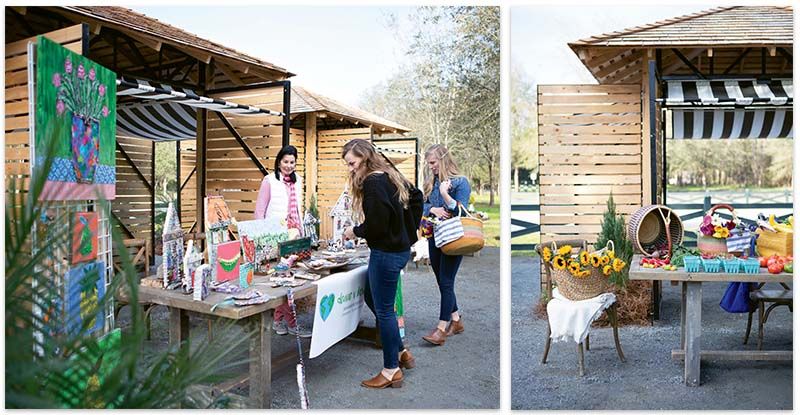Kiawah River, the resort-style neighborhood on John’s Island, gives its farm stands a chic twist

Vendors are shaded by Clemson Architecture Center student-designed stands built out of cypress and red cedar.
What do sweetgrass basket stands (like those lining Highway 17 in North Mount Pleasant), dovecotes (shelters that house domesticated pigeons), and Strandkorbs (hooded beach chairs seen up and down the coast of Germany) all have in common? These disparate structures each influenced the design of a pair of unique market stands now at Kiawah River, the 2,000-acre neighborhood-meets-resort community taking shape on John’s Island.
The stands—a far cry from the plastic-topped tents ubiquitous to farmers markets—were designed and hand-built by nine students from the Clemson Architecture Center in Charleston. “The intent is for these structures to eventually blend into the landscape and respect the agrarian archetype of John’s Island,” says David Pastre, a senior lecturer at the Clemson Architecture Center and coordinator of the school’s Architecture + CommunityBUILD program, who mentored the students throughout the design process.
To that end, slats of locally sourced cypress form the walls of the stands; their hipped roofs (a nod to dovecotes) are made of red cedar shingles, that—like the cypress—will develop a silvery gray patina over time. When their doors are swung open, canvas awnings unfurled, and interior lights illuminated, they’ll provide comfortable shopping space within the Farmstead (or marketplace) section of Kiawah River throughout the year. When not in use, they flank the community’s entrance.
Why all the fanfare for a pair of market stands? The Kiawah River team wanted to provide the rotating array of sea island farmers and artisans an exceptional space from which to sell their goods—from local veggies and raw honey to candles and wildflowers.
“We are dedicated to preserving and managing land and waterways, but also to promoting education and resources across the sea islands,” says Kiawah River managing director Carter Redd, who adds that half of the community’s 2,000 acres will go undeveloped and 100 acres will remain a working farm owned by the Freeman family.
“The development of the Farmstead as part of Kiawah River falls in line with our goals by showing awareness of the impact residential development will have on rural John’s Island,” says Pastre. “We are happy to support the effort to introduce entrepreneurial opportunities for local residents within the development.”
Shop the stands on Farmstead Field Day, April 20 from 1-5 p.m.—more info is available at kiawahriver.com.